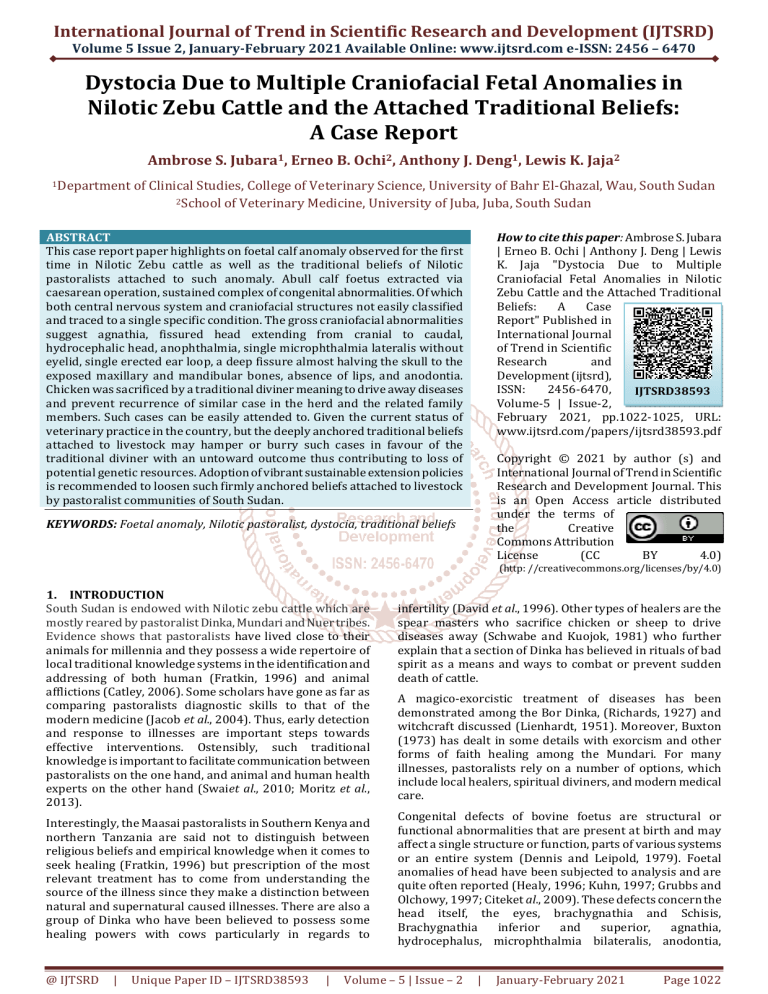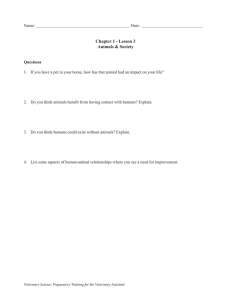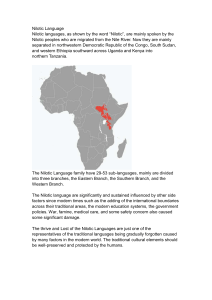
International Journal of Trend in Scientific Research and Development (IJTSRD)
Volume 5 Issue 2, January-February 2021 Available Online: www.ijtsrd.com e-ISSN: 2456 – 6470
Dystocia Due to Multiple Craniofacial Fetal Anomalies in
Nilotic Zebu Cattle and the Attached Traditional Beliefs:
A Case Report
Ambrose S. Jubara1, Erneo B. Ochi2, Anthony J. Deng1, Lewis K. Jaja2
1Department
of Clinical Studies, College of Veterinary Science, University of Bahr El-Ghazal, Wau, South Sudan
2School of Veterinary Medicine, University of Juba, Juba, South Sudan
ABSTRACT
This case report paper highlights on foetal calf anomaly observed for the first
time in Nilotic Zebu cattle as well as the traditional beliefs of Nilotic
pastoralists attached to such anomaly. Abull calf foetus extracted via
caesarean operation, sustained complex of congenital abnormalities. Of which
both central nervous system and craniofacial structures not easily classified
and traced to a single specific condition. The gross craniofacial abnormalities
suggest agnathia, fissured head extending from cranial to caudal,
hydrocephalic head, anophthalmia, single microphthalmia lateralis without
eyelid, single erected ear loop, a deep fissure almost halving the skull to the
exposed maxillary and mandibular bones, absence of lips, and anodontia.
Chicken was sacrificed by a traditional diviner meaning to drive away diseases
and prevent recurrence of similar case in the herd and the related family
members. Such cases can be easily attended to. Given the current status of
veterinary practice in the country, but the deeply anchored traditional beliefs
attached to livestock may hamper or burry such cases in favour of the
traditional diviner with an untoward outcome thus contributing to loss of
potential genetic resources. Adoption of vibrant sustainable extension policies
is recommended to loosen such firmly anchored beliefs attached to livestock
by pastoralist communities of South Sudan.
How to cite this paper: Ambrose S. Jubara
| Erneo B. Ochi | Anthony J. Deng | Lewis
K. Jaja "Dystocia Due to Multiple
Craniofacial Fetal Anomalies in Nilotic
Zebu Cattle and the Attached Traditional
Beliefs:
A
Case
Report" Published in
International Journal
of Trend in Scientific
Research
and
Development (ijtsrd),
ISSN:
2456-6470,
IJTSRD38593
Volume-5 | Issue-2,
February 2021, pp.1022-1025, URL:
www.ijtsrd.com/papers/ijtsrd38593.pdf
Copyright © 2021 by author (s) and
International Journal of Trend in Scientific
Research and Development Journal. This
is an Open Access article distributed
under the terms of
the
Creative
Commons Attribution
License
(CC
BY
4.0)
KEYWORDS: Foetal anomaly, Nilotic pastoralist, dystocia, traditional beliefs
(http: //creativecommons.org/licenses/by/4.0)
1. INTRODUCTION
South Sudan is endowed with Nilotic zebu cattle which are
mostly reared by pastoralist Dinka, Mundari and Nuer tribes.
Evidence shows that pastoralists have lived close to their
animals for millennia and they possess a wide repertoire of
local traditional knowledge systems in the identification and
addressing of both human (Fratkin, 1996) and animal
afflictions (Catley, 2006). Some scholars have gone as far as
comparing pastoralists diagnostic skills to that of the
modern medicine (Jacob et al., 2004). Thus, early detection
and response to illnesses are important steps towards
effective interventions. Ostensibly, such traditional
knowledge is important to facilitate communication between
pastoralists on the one hand, and animal and human health
experts on the other hand (Swaiet al., 2010; Moritz et al.,
2013).
Interestingly, the Maasai pastoralists in Southern Kenya and
northern Tanzania are said not to distinguish between
religious beliefs and empirical knowledge when it comes to
seek healing (Fratkin, 1996) but prescription of the most
relevant treatment has to come from understanding the
source of the illness since they make a distinction between
natural and supernatural caused illnesses. There are also a
group of Dinka who have been believed to possess some
healing powers with cows particularly in regards to
@ IJTSRD
|
Unique Paper ID – IJTSRD38593
|
infertility (David et al., 1996). Other types of healers are the
spear masters who sacrifice chicken or sheep to drive
diseases away (Schwabe and Kuojok, 1981) who further
explain that a section of Dinka has believed in rituals of bad
spirit as a means and ways to combat or prevent sudden
death of cattle.
A magico-exorcistic treatment of diseases has been
demonstrated among the Bor Dinka, (Richards, 1927) and
witchcraft discussed (Lienhardt, 1951). Moreover, Buxton
(1973) has dealt in some details with exorcism and other
forms of faith healing among the Mundari. For many
illnesses, pastoralists rely on a number of options, which
include local healers, spiritual diviners, and modern medical
care.
Congenital defects of bovine foetus are structural or
functional abnormalities that are present at birth and may
affect a single structure or function, parts of various systems
or an entire system (Dennis and Leipold, 1979). Foetal
anomalies of head have been subjected to analysis and are
quite often reported (Healy, 1996; Kuhn, 1997; Grubbs and
Olchowy, 1997; Citeket al., 2009). These defects concern the
head itself, the eyes, brachygnathia and Schisis,
Brachygnathia
inferior
and
superior,
agnathia,
hydrocephalus, microphthalmia bilateralis, anodontia,
Volume – 5 | Issue – 2
|
January-February 2021
Page 1022
International Journal of Trend in Scientific Research and Development (IJTSRD) @ www.ijtsrd.com eISSN: 2456-6470
fissure cerebral is and missing nostrils. Moreover, congenital
defects of Central Nervous System (CNS) and craniofacial
skeleton have reported (Dennis and Leipold, 1986). Cyclopic
anomaly has been observed in buffalo calf (Thippeswamyet
al., 1996) in lambs (Binnset al., 1960) in goats (Chakrabarti
and Pal, 1991) in piglets (Bacon and Mathis, 1983; Evans,
1987) and in man (Bacon and Mathis, 1983) .
Hydrocephalus condition is well documented in cattle
(Sharda and Ingole, 2002; Purohit et al., 2006; Jana and
Ghosh, 2010; Muruganet al., 2014) in Mare (Kumar et al.,
2010; Ferris et al., 2011) in Buffalo (Bugaliaet al., 1990) and
in Pig (Arthur, 1975). Consequently, caesarean operation has
been reported to be the common remedial intervention in
most of the cases of foetal anomalies. To our best knowledge,
similar condition of combination of severe congenital
abnormalities affecting craniofacial structures has not been
reported in South Sudan. As such, very little has been written
on these subjects about the numerous Nilotic cattle-or
culture of the people of South Sudan. Moreover, a similar
information about traditional Veterinary beliefs and
practices has even more immediate implications for animal
health. Based on these beliefs, a good number of animals
sustaining anomalies and diseases of unacquainted
symptoms occurring in many communities in South Sudan.
Accordingly, they are either culled by slaughtering, sold or
killed and disposed as a result of beliefs. Many of such events
have been continuing unabated without being documented.
Therefore, the aim of this case report is to highlight on foetal
calf anomalies and traditional beliefs attached to in South
Sudan.
2. Materials and Methods
2.1. Case History
A multiparous zebu cow was brought to the clinic of the
College of Veterinary Science, University of Bahr El-Ghazal
with a complain that, the cow was almost 10 months
pregnant and started to show sign of labour for nearly 48
hrs. However, the intervention of the traditional pastoralists
was unsuccessful.
2.2. Clinical Examination
Obstetrical examination via rectal palpation and vaginal
examination revealeddorso-sacral anterior presentation,
weak foetal movement, closed cervix with persistent uterine
contraction. Tentatively, the case was diagnosed to be
dystocia at the second stage of labor.
2.3. Intervention
Limitation of some diagnostic tools such as ultrasound or xray to reveal more details led to adoption of caesarean
operation as the easiest fast remedial approach of choice to
resolve the case (Figure 1) .The operation was carried out to
extract the foetus according to procedures described by
Anushaet al. (2016) for one-hour.
hydrocephalic head, agnathia, microphthalmia unilateral is,
anodontia, deep fissure from cranial to caudal bisecting the
skull to be maxillary and mandibular bones, missing nostrils,
small lips, short single erected ear lope and swollen neck
(Figure 2). Moreover, cases of hydrocephalus and cyclopia in
cattle were described separately by several authors (Mouli,
1987; Kuhn, 1997; Grubbs and Olchowy, 1997;
Balasubramanian et al., 1997; Venuet al., 2001; Sharda and
Ingole, 2002; Ozcanet al., 2006; Citeket al., 2009).
Therefore, a calf cannot be easily classified and traced to a
single specific condition of known foetal anomalies which is
in line with a similar case reported by DiMuro et al. (2020).
However, discrepancies in thorough description of the
lesions were attributed to limitations in tools for detailed
necropsy findings, radiography and computed tomography/
Magnetic Resonance Image (MRI) as done in human cases.
These limitations concurred with the report of Di Muroet al.
(2020) .
Seemingly, foetal anomalies are not uncommon among the
Nilotic zebu cattle of pastoralists in South Sudan. However,
the occurrence of these anomaliesis always attached to evil
spirit, bad omen (Lienhardt, 1951). Such abnormalities are
believed to arise from misfortune or unusual causes
(Westerlund, 2006) and therefore a traditional diviner
should be consulted which vividly concurred with the
present case; in which a traditional healer known as
spearman was summoned to the clinic to perform a ritual
event that ended with sacrifice of a chicken and spraying its
blood on the cow’s body in a belief of driving the disease
away from the herd and the immediate family or clan of the
cow’sowner (Schwabe and Kuojok, 1981).
Interestingly, similar beliefs inthe rites of evil spirit which is
regarded as a means and ways to combat or prevent death of
cattle or preventive measures arecommonly shared among
sections of the Dinka tribe, Mundari and Maasai pastoralists
(Buxton, 1973; Fratkin, 1996) .
4. Conclusions
This case repots reveals the observation of a foetal calf
anomaly for the first time in Nilotic Zebu cattle in South
Sudan. Although a few pastoral communities begin to adopt
modern veterinary medical practices, yet the deeply
cultivated mind set of possessing cattle for prestige can help
much in cementing such beliefs attached to the animals.
Therefore, adoption of vibrant policies for providing quality
extension services to loosen these beliefs should be
rigorously instituted for sustainable development of
livestock sector in South Sudan.
2.4. Ethno veterinary Beliefs
Following the caesarean operation, information about
traditional veterinary beliefs and practices on animal health
among the pastoral communities was collected from key
stakeholders, records, reports and reviews of literature.
3. Results and Discussions
An abnormal, weak bull calf foetus was extracted but died
shortly after the operation. Multiple gross lesions were
observed on craniofacial skeleton represented by
@ IJTSRD
|
Unique Paper ID – IJTSRD38593
|
Figure 1: Nilotic Zebu Cow in post-operation condition
Volume – 5 | Issue – 2
|
January-February 2021
Page 1023
International Journal of Trend in Scientific Research and Development (IJTSRD) @ www.ijtsrd.com eISSN: 2456-6470
Figure 2: Caesarean Extracted Nilotic ZebuFoetus showing anomalie
5. REFERENCES
[1] Anusha, K., Praveenraj, M. and Venkata Naidu, G.
2016. Incidence of dystocia in small ruminants: A
retrospective study. Indian Vet. J. 93 (10), 40-42.
[11]
David, A., Blakeway, S., and Linquist, B. J. 1996.
Etheno-Veterinary Knowledge of the Dinka and Nuer
in South Sudan. UNICEF OLS/SS Livestock program,
Pp 24-27
[2]
Arthur, G. H. 1975. Veterinary reproduction and
obstetrics. Fourth edition. Bailliere Tindall, Pp, 115116.
[12]
Dennis, S. M. and Leipold, H. W. 1979. Ovine
congenital defects. Vet. Bull., 49, 233-239.
[13]
[3]
Bacon, W. and Mathis, R. 1983. Craniofacial
characteristics of cyclopia in man and swine. Angle
Orthod., 53, 290-310.
DiMuro G., Cagnottis G., Bellino C., Capucchio M. T.,
Colombino E., and D’Angel A. 2020. Multiple Cepalic
malformation in a calf. MDPI, (10) 9-IO 3390/AND
10091532
[4]
Balasubramanian, S., Ashokan, S. A., Seshagiri, V. N.
and Pattabiraman, S. R. 1997. Congenital internal
hydrocephalus in a calf. Indian Vet J., 74, 446-447.
[14]
Evans, H. E. 1987. Cyclopia, situs inversus and widely
patent ductus arteriosus in a new-born pig, Sus scrofa.
Anat. Histol. Embryol., 16, 221-226.
[5]
Binns, W., Anderson, W. A. and Sullivan, D. J. 1960.
Further observations on a congenital cyclopian-type
malformation in lambs. J. Am. Vet. Med. Assoc., 137,
515-521.
[15]
Ferris, R. A., Sonnis, J., Webb, B., Lindholm, A. and
Hassel, D. 2011. Hydrocephalus in an American
miniature horse foal: A case Report and Review.
Journal of Equine Veterinary Science, 31, 611-614.
[6]
Bugalia, N. S., Chander, S., Chadolia, R. K., Verma, S. K.,
Singh, P. and Sharma, O. K. 1990. Monstrosities in
Cows and Buffaloes. Indian Veterinary Journal, 67,
1042-1043.
[16]
Fratkin, E. 1996. Traditional medicine and concepts of
healing among Samburu pastoralists of Kenya. J
Ethnobiol. Society of Ethnobiology, 16, 63-98.
[17]
[7]
Buxton, J. 1973. Religion and Healing in Mundari.
Oxford: Oxford University Press.
Grubbs, S. T. And Olchowy, T. W. J. 1997. Bleeding
disorders in cattle- a review and diagnostic approach.
Veterinary Medicine, 92, 737-743
[8]
Catley A. 2006. Use of participatory epidemiology to
compare the clinical veterinary knowledge of
pastoralists and veterinarians in East Africa. Trop
Anim Health Prod., 38 (3), 171-184.
[18]
Healy, P. J. 1996. Testing for undesirable traits in
cattle- an Australian perspective. Journal of Animal
Science, 74, 917-922.
[19]
[9]
Chakrabarti, A., and Pal, A. 1991. Cyclopia
prostomusarrhynchus in a black Bengal goat. Indian
Vet. J., 68, 985-986.
Jackson, H. C. 1923. The Nuer of the Upper Nile
Province. Sudan Notes and Records, 6, 60-107, 123189.
[20]
[10]
Citek J., Rehout V., Hajkova J. andPavkova J. 2009.
Congenital disorders in cattle population of the Czech
Republic, Czech J. Anim. Sci., 54 (2), 55-64.
Jacob, M. O., Farah, K. O. and Ekaya, W. N. 2004.
Indigenous knowledge: the basis of the Maasai Ethno
veterinary Diagnostic Skills. J Hum Ecol., 16 (1), 4348.
@ IJTSRD
|
Unique Paper ID – IJTSRD38593
|
Volume – 5 | Issue – 2
|
January-February 2021
Page 1024
International Journal of Trend in Scientific Research and Development (IJTSRD) @ www.ijtsrd.com eISSN: 2456-6470
[30]
Richards, M. C. 1927. Medical Treatment by Bor
Witchdoctors. Sudan Notes and Records, 10, 241-242.
[31]
Schwabe, C. W. and Kuojok, I. M. 1981. A Distinctive
Surgical Operation on Bulls Performed in the Nile
Valley from Pharaonic Times.
[32]
Sharda, R. and Ingole, S. P. 2002. Congenital bilateral
hydrocephalus in a Jersey cow calf. A case report.
Indian Vet. J., 79 (10), 965-66.
[33]
Sharma, A. 1996. Dystocia due to hydrocephalic foetus
with downward deviation of head in mare. Indian Vet.
J., 73 (3), 337-338
Moritz, M., Ewing, D. andGarabed, R. 2013. On not
knowing zoonotic diseases: Pastoralists’ ethnoveterinary knowledge in the far north region of
Cameroon. Human Organ. Society for Applied
Anthropology, 72 (1), 1-11. PMID: 23990687
[34]
Swai, E. S., Schoonman, L., and Daborn, C. 2010.
Knowledge and attitude towards zoonoses among
animal health workers and livestock keepers in
Arusha and Tanga, Tanzania. Tanzan J Health Res.
National Institute for Medical Research, 12 (4), 272–7.
[26]
Mouli, S. P. 1987. Surgical correction of congenital
external hydrocephalus in an Ongole bull calf. Indian
Vet J., 64, 696-698.
[35]
[27]
Murugan, M. S., Parthiban, S., Malmarugan, S. and
Raheswar, J. J. 2014. Management of dystocia due to
hydrocephalus fetusin a cow. Intaspolivet., 15 (2),
338-339.
Thippeswamy, T., Prasad, R. V. and Kakade, K. 1996. A
clinical case of cyclopia prostomusarrhynchus in a
buffalo calf (Bubalus bubalis). Indian Vet. J. 73, 674676.
[36]
Titherington, G. W. 1927. The Raik Dinka of Bahr el
Ghazal Province. Sudan Notes and Records 10, 159210.
[21]
Jana, D. and Ghosh, M. 2010. Congenital internal
hydrocephalus in a new born cow calf. Indian J Anim.
Reprod., 31, 63-64.
[22]
Kuhn, C. 1997. Molecular genetic background of
inherited defects in cattle (German). Archives of
Animal Breeding, 40, 121-127.
[23]
Kumar, A., Ghuman, S. P. S. andHonparkhe, M. 2010.
Successful delivery of hydrocephalic foal through
fetotomy in a mare. Indian J Anim. Reprod., 31, 83-84.
[24]
Lienhardt, G. 1951. Some Notions of Witchcraft
among the Dinka. Africa 21, 303-318.
[25]
[28]
Ozcan, K., Gurbulack, K., Takci, I., et al. 2006. A typical
cyclopia in a brown Swiss cross calf: a case report.
AnatHistolEmbryol., 35, 152-154.
[37]
Venu, R., Reddy, P. C. S. and Dhanalakshmi, N. 2001.
Cyclopia in a Jersey cross bred calf- a case report,
Indian Vet J, 78:657.
[29]
Purohit G. N., Gaur, M. and Sharma A. 2006. Dystocia
in Rathi cows due to congenital hydrocephalus. Indian
J Anim Reprod 27 (1), 98-99.
[38]
Westerlund, D. 2006. African Indigenous Religion and
Disease Causation: From Spiritual Beings to Living
Humans. Volume 38, Brill, Leiden, Boston.
@ IJTSRD
|
Unique Paper ID – IJTSRD38593
|
Volume – 5 | Issue – 2
|
January-February 2021
Page 1025



